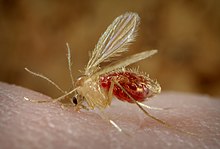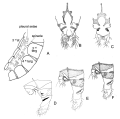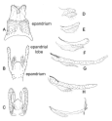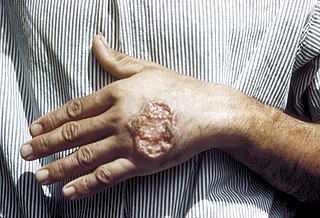
Leishmaniasis is a wide array of clinical manifestations caused by protozoal parasites of the Trypanosomatida genus Leishmania. It is generally spread through the bite of phlebotomine sandflies, Phlebotomus and Lutzomyia, and occurs most frequently in the tropics and sub-tropics of Africa, Asia, the Americas, and southern Europe. The disease can present in three main ways: cutaneous, mucocutaneous, or visceral. The cutaneous form presents with skin ulcers, while the mucocutaneous form presents with ulcers of the skin, mouth, and nose. The visceral form starts with skin ulcers and later presents with fever, low red blood cell count, and enlarged spleen and liver.

Sandfly or sand fly is a colloquial name for any species or genus of flying, biting, blood-sucking dipteran (fly) encountered in sandy areas. In the United States, sandfly may refer to certain horse flies that are also known as "greenheads", or to members of the family Ceratopogonidae. The bites usually result in a small, intensely itchy bump or welt, the strength of which intensifies over a period of 5-7 days before dissipating. Moderate relief is achieved with varying success through the application of over the counter products such as Benadryl (ingested) or an analgesic cream such as After Bite. Outside the United States, sandfly may refer to members of the subfamily Phlebotominae within the Psychodidae. Biting midges (Ceratopogonidae) are sometimes called sandflies or no-see-ums. New Zealand sandflies are in the genus of sand fly Austrosimulium, a type of black fly.

Lutzomyia is a genus of phlebotomine sand flies consisting of nearly 400 species, at least 33 of which have medical importance as vectors of human disease. Species of the genus Lutzomyia are found only in the New World, distributed in southern areas of the Nearctic and throughout the Neotropical realm. Lutzomyia is one of the two genera of the subfamily Phlebotominae to transmit the Leishmania parasite, with the other being Phlebotomus, found only in the Old World. Lutzomyia sand flies also serve as vectors for the bacterial Carrion's disease and a number of arboviruses.

Phlebotomus is a genus of "sand flies" in the Diptera family Psychodidae. In the past, they have sometimes been considered to belong in a separate family, Phlebotomidae, but this alternative classification has not gained wide acceptance.
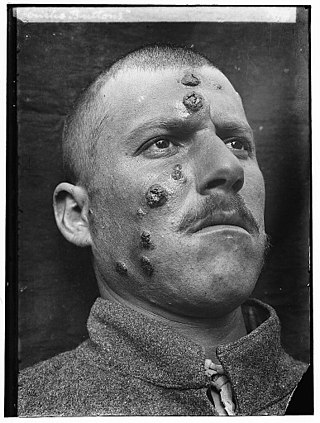
Cutaneous leishmaniasis is the most common form of leishmaniasis affecting humans. It is a skin infection caused by a single-celled parasite that is transmitted by the bite of a phlebotomine sand fly. There are about thirty species of Leishmania that may cause cutaneous leishmaniasis.

Psychodidae, also called drain flies, sink flies, filter flies, sewer flies, or sewer gnats, is a family of true flies. Some genera have short, hairy bodies and wings, giving them a "furry" moth-like appearance, hence one of their common names, moth flies. Members of the sub-family Phlebotominae, which are hematophagous, may be called sand flies in some countries, although this term is also used for other unrelated flies.

Lutzomyia adiketis is an extinct species of sandfly in the moth fly subfamily Phlebotominae. L. adiketis is a vector of the extinct Paleoleishmania neotropicum and both species are solely known from early Miocene Burdigalian stage Dominican amber deposits on the island of Hispaniola.
Pintomyia falcaorum is an extinct species of sandfly in the moth fly subfamily Phlebotominae. P. falcaorum is solely known from early Miocene Burdigalian stage Dominican amber deposits on the island of Hispaniola.

Robert Killick-Kendrick was a British parasitologist with interests in the vectors of infectious diseases, in particular phlebotomine sandflies. His work on malaria, trypanosomiasis, leishmaniasis and other parasitological infections are numerous and diverse. He published more than 300 articles and scientific contributions.
Lutzomyia shannoni is a species of fly in the subfamily Phlebotominae, the phlebotomine sand flies. It is native to the Americas from the southeastern United States to northern Argentina. It has a disjunct distribution, and is only found in regions with suitable climates, habitat types, and host animals. It is well known as a vector of the vesicular stomatitis virus, which causes the disease vesicular stomatitis in animals, particularly livestock.
Lutzomia anthrophora is a species of what is commonly known as the sandfly in the order Diptera and it is a common vector for Leishmania mexicana.
Endotrypanum schaudinni is a parasite found only in Hoffmann's two-toed sloth. This sloth is found throughout South America in forested areas and this parasite is found throughout the population. Hoffman’s two-toed sloth is the only host species so it is of little economic or medical importance in humans. Endotrypanum schaudinni is transferred by an intermediate host of sandflies from the genus Lutzomyia. The highest concentration of flagellates in these insects is found in the pylorus region of this vector which may be important to transmission to the host. E. schaudinni is an intracellular parasite which invades the red blood cells of its definitive host. Little research has been done on the mechanism of action of this or the benefit of residing in the red blood cells but antigenic masking seems a possible reason. E. schaudinni is a hemoflagellate with a size of about 13.5 μm in length and 3.5 μm in diameter. Another point of interest is that E. schaudinni shares many of the same gene sequences as Leishmania, and two unique gene sequences were found in 2009 for diagnostic purposes. This diagnostic technique is an important factor in further studies of this parasite as identifying it but classical biochemical and ultrastructural parameters is unreliable.
Psathyromyia carpenteri was first described as Phlebotomus carpenteri in 1953. The species name is dedicated to Col. Stanley Jennings Carpenter, M.S.C., U.S. Army, under whose direction most of the first described specimens were collected.

Jean-Antoine Rioux (1925–2017) was a French parasitologist, mainly a specialist of leishmaniasis. He coined the term ecoepidemiology for a discipline combining concepts of ecology and epidemiology to understand parasite transmission patterns and processes. He was a professor at the University of Montpellier, France, and one of the founders of the Société Française de Parasitologie in 1962.
Evandromyia chacuensis is a species of sand fly first circumscribed in 2018 from specimens collected in Argentina. It is the 12th species currently described in the subgenus Barrettomyia.

Lutzomyia longipalpis is a species complex of sandfly belonging to the family Psychodidae. This species is primarily present in Central and South America, but has also appeared in Mexico. There have been reports of L. longipalpis as far south as Argentina, as they are found in a wide variety of ecological conditions. Both males and females feed on sugars from plants and aphids, but only adult females feed on the blood of other mammals. The species has recently begun appearing in urban areas throughout Brazil, and serves as a key vessel for the propagation of the parasite Leishmania infantum. The presence of these flies appears to be strongly correlated to the presence of domestic chickens in Latin America. The first major urban outbreak of the lethal Visceral leishmanias epidemic was detected in Teresina, Piauí State in the early 1980s following a massive planting of acacias.

Maria Cristina Ferro de Carrasquilla (1947–2015) was a Colombian microbiologist and Leishmaniasis researcher who worked for more than forty years at the National Health Institute of Colombia. Most of her research was focused on sandflies, which are Leishmaniasis vectors, contributing with the description of three new species: Lutzomyia torvida,Lutzomyia falcata,and Lutzomyia tolimensis. Given her research contributions, a sandfly species was named after her: Lutzomyia ferroae. Ferro also worked with Venezuelan equine encephalitis virus and received the Emeritus Researcher award from the National Health Institute of Colombia in 2007.
Evandromyia is a genus of sand fly first circumscribed in 1941. It is subdivided into three subgenera, which are further subdivided into series.
María Dora Feliciangeli was Professor of Medical Entomology at the University of Carabobo, Venezuela, who worked on the transmission of tropical parasites especially American trypanosomiasis and leishmaniasis. She was Coordinator of the National Reference Center of Sandflies and the Medical Entomology Section.

Phlebotomus papatasi is a species of insects commonly known as sandflies. Due to their ectothermic climate limitations, P. papatasi are confined to regions with temperatures above sixty degrees Fahrenheit for at least three months of the year, spanning over much of the European Mediterranean, North Africa, the Middle East, and Central Asia. Around one thousand sandfly species have been described, belonging to the subfamily Phlebotominae within the family Psychodidae. The Psychodidae family belongs to the order Diptera within the class Insecta of the subphylum Hexapoda of the Arthropod phylum.
